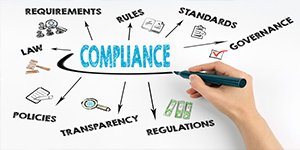All mail deemed to be customer communication is collected and transmitted to a central system, regardless of in what area, in what format, and on what physical and digital channel the correspondence is created and output. While the processor sends the documents to output as hard-copy print or sends it as a PDF attachment in an email, or as embedded HTML it can then immediately be indexed and archived at the same time.
All of these processes run automatically in the background. Ideally, a rules check is integrated here, including for compliance with corporate identity (wording, layout, fonts, etc.) and legal obligations (archiving, reporting, data protection) and even release mechanisms (four-eyes principle, etc.) In particular, banks, insurers, healthcare, governmental agencies and telecommunications providers are faced with a complex maze of regulatory requirements. How can they possibly meet them without a reliable and central IT-supported check procedure?
First the Analysis, Then the Cross Check
One thing is for certain. Quality assurance encompasses a multitude of things, such as a check of the content (Is the data correct and complete? Are all CI and compliance regulations observed?) as well as a technical production check (Can the files be output and further processed? Are all the control codes for enveloping, postage optimization, etc. present?), and of course, validating the IT itself; how do modifications and updates affect a specific system, other applications and the document? If documents were converted, does the content of the original match the output?
For these reasons, a thorough quality check is always tied to a process analysis. Where can rule violations or bottlenecks occur in production? Is data consistent? What document-generating systems are subject to frequent updates? Do these modifications affect document creation at all? The answers ultimately determine what type of check is needed at what point during document processing. Processors and specialist users must be included in that analysis so the entire CCM document cycle can be examined for possible vulnerability points.







